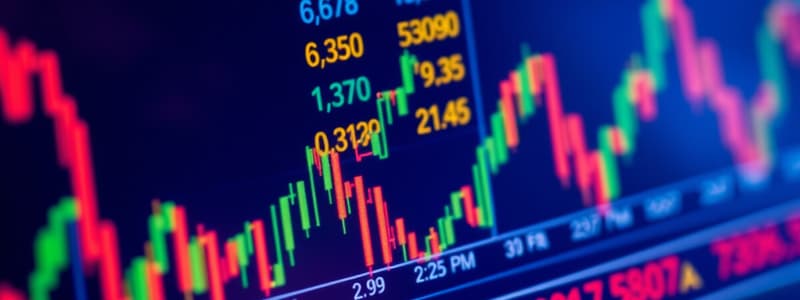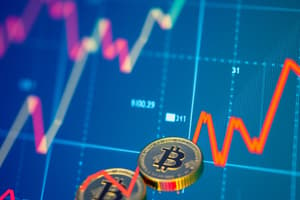Podcast
Questions and Answers
Which of the following accurately describes a derivative?
Which of the following accurately describes a derivative?
- It is a financial instrument that is independent of any underlying asset.
- It derives its value from the price of an underlying instrument such as stocks or commodities. (correct)
- It is exclusively used for non-financial transactions.
- It always requires immediate execution without future commitments.
What is the primary difference between options and forwards/futures contracts?
What is the primary difference between options and forwards/futures contracts?
- Options provide the buyer the right, but not the obligation, to buy/sell. (correct)
- Options require the parties to transact at the spot market price.
- Forwards/futures offer flexibility in contract terms while options do not.
- Forwards/futures always have a higher financial risk compared to options.
In which market are customized contracts typically utilized?
In which market are customized contracts typically utilized?
- Derivatives Market
- Over-the-Counter Markets (correct)
- Spot Market
- Exchange Listed Markets
What is the primary purpose of arbitrage in financial markets?
What is the primary purpose of arbitrage in financial markets?
Which statement is true regarding American options?
Which statement is true regarding American options?
What does it mean for a call option to be considered 'in the money'?
What does it mean for a call option to be considered 'in the money'?
Which scenario best describes the position of a writer of a put option?
Which scenario best describes the position of a writer of a put option?
Which of the following best describes intrinsic value for a put option?
Which of the following best describes intrinsic value for a put option?
What does the term 'open interest' refer to in options trading?
What does the term 'open interest' refer to in options trading?
What is the correct definition of a European option?
What is the correct definition of a European option?
What does a high Put/Call Ratio (PCR) indicate about market sentiment?
What does a high Put/Call Ratio (PCR) indicate about market sentiment?
How is the intrinsic value of a European call option determined when at the money?
How is the intrinsic value of a European call option determined when at the money?
What is the minimum value of an out-of-the-money American put option?
What is the minimum value of an out-of-the-money American put option?
Which factor is most likely to increase the time value of an option?
Which factor is most likely to increase the time value of an option?
What happens to the time value of an option as it approaches its expiration date?
What happens to the time value of an option as it approaches its expiration date?
Flashcards are hidden until you start studying
Study Notes
Underlying Instruments
- Financial instruments include bonds, stocks, currencies, indexes, and derivatives.
- Non-financial instruments include commodities (metals, grains, livestock, electricity, gas, oil) and weather-related derivatives.
Derivatives
- A derivative is a financial contract whose value derives from an underlying asset, executed at a future date.
- Types of derivatives: Options, Forwards/Futures, and Swaps.
Options
- Options are contracts that give the purchaser the right, but not the obligation, to buy/sell an underlying asset at a specific price before or at expiration.
Forwards/Futures
- Contracts obligating the exchange of goods at a predetermined future date and price.
Swaps
- Agreements where two parties exchange future cash flows from different financial instruments.
Speculation & Markets
- Speculating involves predicting market movements and taking action based on those beliefs.
- Spot market transactions involve immediate delivery of financial instruments.
Arbitrage
- Arbitrage profits occur when traders take advantage of price discrepancies in different markets.
Option Types
- American Option: Can be exercised any time before or on expiration.
- European Option: Can only be exercised on the expiration date.
Option Pricing
- Premium: The cost paid by the buyer to the seller for rights conferred by the option.
- Exercise Price (Strike Price): The price agreed for the execution of the option contract.
- Intrinsic Value: The current value of the option if exercised today, calculated differently for call and put options.
Market Efficiency
- Law of one price: The price of an identical asset should be the same across markets.
- Arbitrage indicates market inefficiencies.
Position Types
- Long Position: Taker of the option; expects price to rise.
- Short Position: Writer of the option; expects price to fall.
Call vs. Put Options
- Call Options: Right to buy; profitable if the asset price exceeds the strike price.
- Put Options: Right to sell; profitable if the asset price is below the strike price.
Market Indicators
- Open Interest: Total number of outstanding option contracts.
- Put/Call Ratio (PCR): Analyzes market sentiment—higher PCR indicates bearishness.
Intrinsic and Time Value
- The intrinsic value varies with the underlying asset's spot price relative to the strike price.
- Time value reflects the potential for value increase prior to expiration, higher for options with longer durations and greater volatility.
Option Boundaries
- Options cannot sell for less than zero.
- Maximum values differ between American and European options, with American options generally having higher potential due to early exercise privileges.
Earnings and Dividends
- Dividends affect the intrinsic value of options, making it advantageous to exercise before dividends are distributed.
Early Exercise
- American options provide the flexibility to exercise before expiration, unlike European options, which do not allow pre-expiration exercise.
These notes encompass critical aspects of derivatives, options, their pricing mechanisms, market behaviors, and the implications of dividends and early exercise.### Options Pricing and Characteristics
-
Time Value: The value of options increases with more time to expiration, while less time decreases value.
-
American vs. European Options:
- American Puts are valued higher than European Puts due to the flexibility to exercise at any time before expiration.
- American Calls are valued greater than or equal to European Calls.
- Early exercise of American Puts is optimal only if stock prices drop sufficiently; dividends decrease the likelihood of early exercise.
Interest Rates Influence
-
Call Options:
- Call options allow investors to save capital by investing a smaller amount upfront, leaving the rest for other investments, like term deposits.
- Example: Investing 1,000inacalloptionallows1,000 in a call option allows 1,000inacalloptionallows9,000 to be placed in a term deposit, potentially yielding more upon execution of the option.
-
Put Options:
- Puts offer the right to sell at a future date, essentially delaying a sale.
- Higher interest rates decrease the value of put options as immediate sale offers better investment opportunities.
Volatility Effects
- Increased volatility raises the value of both Call and Put options.
- Calls can yield higher profits if the market rises, but losses are capped.
- Puts limit losses to the premium paid, making them valuable if anticipating price declines.
Put-Call Parity
- A crucial concept in options trading that relates the price of call and put options.
- It involves two portfolios:
- Portfolio A contains a European Put option and a stock.
- Portfolio B contains a European Call option and a bond at a risk-free rate.
- Payoffs of both portfolios are equivalent at expiration, maintaining parity:
- When stock price (ST) is less than exercise price (X): Payoff equals X.
- When ST is greater than X: Payoff equals ST.
Value Relationships
- For European options:
- Value of a European Put: Call Option + Bond - Stock
- Value of a European Call: Stock + Put Option - Bond
- American options can incorporate present value of dividends into their valuations.
Example Scenarios
-
Example 1:
- ANZ Call Options:
- Cost: 0.52,SpotPrice:0.52, Spot Price: 0.52,SpotPrice:15.74, Expiration Time: 86/365, Exercise Price: $16.00.
- ANZ Put Options:
- Cost: 0.60,samespotpriceandexpiration,exerciseprice:0.60, same spot price and expiration, exercise price: 0.60,samespotpriceandexpiration,exerciseprice:16.00.
- Higher put cost explained by it being "in the money" while the call is "out of the money."
- Calculations validate that Put-Call Parity holds under given conditions.
- ANZ Call Options:
-
Example 2:
- Demonstrating that "At the Money" call options will be worth more than “At the Money” put options when the spot price equals the exercise price.
- Manipulation of put-call parity formula shows that call price equals put price plus the risk-free rate.
Studying That Suits You
Use AI to generate personalized quizzes and flashcards to suit your learning preferences.




